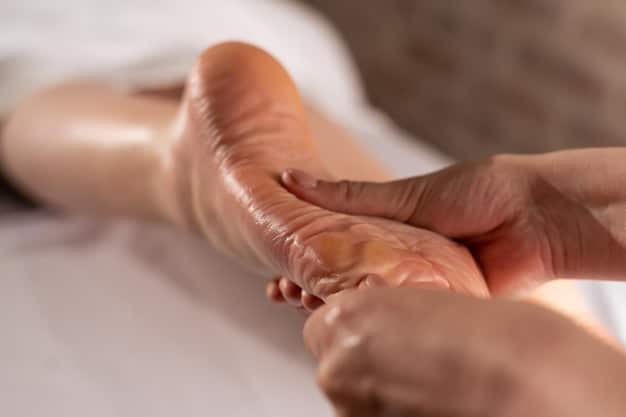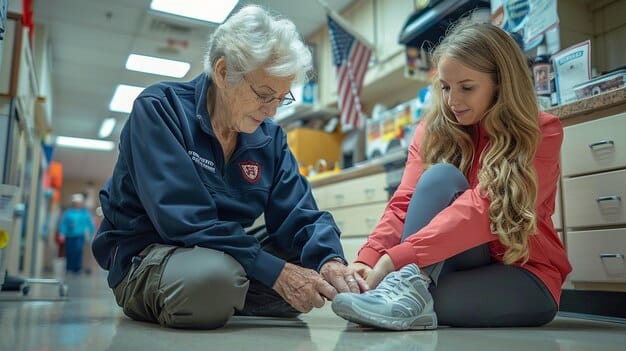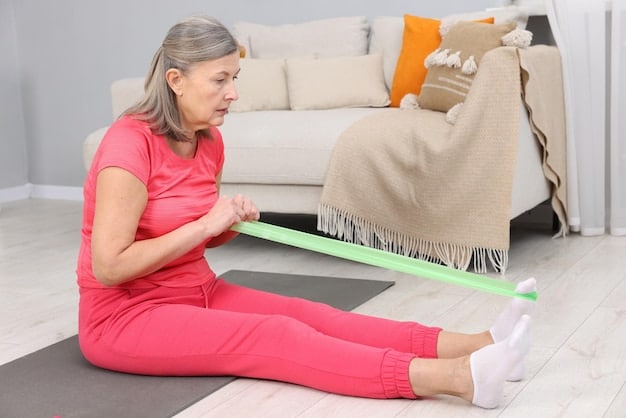Senior Foot Care: Preventing Common Foot Problems & Mobility Issues

Proactive senior foot care is essential for preventing common foot problems and maintaining mobility, which significantly contributes to overall well-being and independence in older adults.
As we age, our bodies undergo various changes, and our feet are no exception. Often overlooked until discomfort strikes, proper senior foot care is paramount for maintaining mobility, independence, and overall quality of life. From common aches to more severe conditions, understanding and addressing potential foot problems proactively can make a significant difference in an older adult’s daily comfort and activity level.
Understanding the Unique Challenges of Senior Foot Health
Aging brings a unique set of challenges to foot health. Years of bearing weight, combined with reduced circulation, loss of protective fatty padding, and changes in skin elasticity, can make feet more vulnerable to various issues. These physiological shifts necessitate a more focused and intentional approach to foot care, differing significantly from the routines of younger individuals.
Common Physiological Changes Affecting Senior Feet
One of the primary changes is the thinning of the protective fatty pads on the soles of the feet, which can lead to increased pressure on bones and joints, causing pain and discomfort. Furthermore, circulation often becomes less efficient with age, reducing the delivery of oxygen and nutrients to the feet and making them more susceptible to infections and slower to heal. Nerve sensitivity may also diminish, potentially masking problems like minor injuries or developing sores until they become more serious.
- Reduced Circulation: Impaired blood flow can lead to cold feet, numbness, and slow wound healing.
- Loss of Fatty Padding: Diminished cushioning increases pressure on joints and bones, causing pain.
- Nerve Damage (Neuropathy): Reduced sensation can prevent early detection of injuries or ulcers.
- Skin and Nail Changes: Drier skin, brittle nails, and fungal infections become more prevalent.
Beyond these internal changes, external factors also play a crucial role. Conditions like arthritis, diabetes, and peripheral artery disease, which are more common in older adults, can severely impact foot health. Arthritis can deform joints and cause stiffness, while diabetes can lead to neuropathy and impaired wound healing, making feet particularly vulnerable to severe complications. Peripheral artery disease restricts blood flow, exacerbating issues related to circulation and healing.
Therefore, a comprehensive understanding of these age-related changes and common co-morbidities is the first step toward effective senior foot care. By recognizing these challenges, caregivers and older adults themselves can implement preventive measures and seek timely professional intervention, ensuring feet remain healthy and functional for as long as possible.
Preventing Common Foot Ailments: A Proactive Approach
Many common foot ailments experienced by seniors are preventable with consistent and attentive care. Focusing on daily hygiene, appropriate footwear, and regular inspections can significantly reduce the risk of developing painful and debilitating conditions. Prevention truly is the best medicine when it comes to maintaining healthy feet in later life.
Daily Hygiene and Inspection Routines
A simple yet effective daily routine is washing the feet with mild soap and warm water, ensuring they are thoroughly dried, especially between the toes, to prevent fungal infections. Following this, applying a good quality moisturizer can help keep the skin supple and prevent cracking, but avoid applying moisturizer between the toes where moisture can promote fungal growth. Daily inspection for cuts, blisters, redness, swelling, or any changes in skin color or temperature is crucial, particularly for individuals with diabetes who may have reduced sensation.
- Wash Daily: Use mild soap and warm water, drying thoroughly, especially between toes.
- Moisturize Regularly: Apply lotion to keep skin supple, avoiding between the toes.
- Inspect Daily: Check for cuts, blisters, swelling, redness, and any unusual changes.
- Trim Nails Properly: Cut nails straight across to prevent ingrown toenails.
Proper nail care is another cornerstone of prevention. Nails should be trimmed straight across, not too short, and filed gently to prevent sharp edges that can lead to ingrown toenails. For those with thick or brittle nails, seeking professional help from a podiatrist is advisable to avoid injury. Ignoring these seemingly minor aspects of foot care can lead to painful complications, impacting an individual’s ability to walk and maintain their independence.
The importance of proper footwear cannot be overstated. Shoes should be well-fitting, providing adequate support and cushioning, with a wide toe box that doesn’t compress the toes. High heels, pointed shoes, or ill-fitting footwear can exacerbate existing conditions or create new ones, such as bunions, hammertoes, or corns and calluses. Socks should be clean, dry, and made of breathable materials, avoiding tight elastic bands that can restrict circulation. Investing in good quality, supportive shoes and maintaining a diligent daily care routine are perhaps the most impactful preventive measures seniors can adopt.
Choosing the Right Footwear and Orthotics for Comfort and Support
The right pair of shoes can be a game-changer for senior foot health, offering critical support, comfort, and protection against injuries and common ailments. Beyond just aesthetic appeal, footwear needs to address the specific anatomical and physiological needs of aging feet, acting as a foundation for overall mobility and well-being.
Key Features of Ideal Senior Footwear
When selecting shoes, prioritize those that offer ample cushioning, especially in the sole, to absorb shock and reduce pressure on joints. A wide and deep toe box is essential to accommodate the toes comfortably without squeezing, which prevents corns, calluses, and bunions. The material should be breathable, like leather or mesh, to prevent moisture buildup and reduce the risk of fungal infections.
- Cushioning: Essential for shock absorption and pressure reduction on joints.
- Wide Toe Box: Prevents squeezing and accommodates foot conditions like bunions.
- Supportive Arch: Helps distribute pressure evenly and supports foot structure.
- Adjustable Fasteners: Velcro straps or laces allow for a customizable fit.
The heel should be low and broad for stability, minimizing the risk of falls. Adjustable fasteners, such as Velcro straps or laces, are preferable as they allow for a customized fit and can accommodate swelling throughout the day. Skipping these features in favor of fashion can lead to debilitating foot pain and increased risk of falls.
Orthotics, either over-the-counter or custom-made, can provide additional support and correct biomechanical imbalances. Custom orthotics, prescribed by a podiatrist, are particularly beneficial for addressing specific conditions like flat feet, plantar fasciitis, or diabetic foot complications. They help align the foot and ankle, distribute pressure evenly, and reduce strain on specific areas, significantly improving comfort and mobility. Even over-the-counter insoles can offer a notable improvement for general discomfort, but it’s crucial to choose those that offer good arch support and cushioning.

Ultimately, investing in proper footwear and considering orthotic solutions is an investment in long-term mobility and independence. It’s not just about comfort; it’s about safeguarding feet from the wear and tear of daily life and preventing conditions that can severely limit an older adult’s ability to enjoy an active lifestyle. Regular consultation with a podiatrist can help guide these choices, ensuring the best possible fit and support for individual needs.
Addressing Specific Foot Problems in Seniors: Corns, Calluses, Bunions, and Ingrown Toenails
While prevention is key, some foot problems are common in seniors and may require specific attention. Understanding these conditions and knowing when to seek professional help can prevent them from escalating and compromising mobility. Corns, calluses, bunions, and ingrown toenails are among the most frequently encountered issues.
Corns and Calluses: Understanding and Management
Corns and calluses are layers of hardened skin that develop in response to repeated friction or pressure. Corns are smaller, often painful, and form on or between toes, while calluses are larger, generally painless, and appear on the soles of the feet. They are often caused by ill-fitting shoes or foot deformities. While over-the-counter remedies like corn pads can offer temporary relief, it’s crucial to remove the source of friction. For severe or persistent corns and calluses, a podiatrist can safely remove the thickened skin, provide advice on appropriate footwear, and address underlying biomechanical issues.
- Corns: Small, painful, form on or between toes, often cone-shaped.
- Calluses: Larger, usually painless, found on soles, caused by friction.
- Removal: Can be trimmed by a podiatrist; self-treatment can be risky.
- Prevention: Properly fitting shoes and protective padding.
Bunions are bony bumps that form at the base of the big toe, causing the toe to angle inward towards the other toes. They are often hereditary but can be exacerbated by tight, narrow shoes. Symptoms include pain, swelling, and redness. Non-surgical treatments like wider shoes, padding, and orthotics can help manage symptoms. In severe cases where pain significantly impacts mobility, surgery may be considered to realign the toe joint.
Ingrown toenails occur when the edge of the toenail grows into the surrounding skin, causing pain, redness, swelling, and sometimes infection. Improper nail trimming is a common cause, as is ill-fitting footwear. Initial treatment involves soaking the foot in warm water and gently attempting to lift the nail edge. However, if there’s pain, redness, pus, or if you have diabetes, it’s imperative to consult a podiatrist who can safely remove the offending part of the nail and prescribe antibiotics if an infection is present. Attempting to dig out an ingrown toenail at home, especially for older adults or those with underlying health conditions, carries a high risk of infection and further complications.
The key to managing these specific foot problems lies in early detection and professional consultation. While some home remedies might offer temporary relief, a podiatrist can accurately diagnose the issue, provide safe and effective treatment, and offer long-term preventive strategies tailored to the individual’s needs, ensuring continued mobility and pain relief.
The Crucial Role of Podiatrists in Senior Foot Care
While daily care and attention to footwear are vital, the expertise of a podiatrist becomes indispensable in the comprehensive senior foot care regimen. These specialists are trained to diagnose, treat, and prevent conditions of the foot, ankle, and lower leg, offering a level of care that goes beyond general medical advice.
When to Consult a Podiatrist
Regular check-ups with a podiatrist are highly recommended for seniors, especially those with underlying conditions like diabetes, arthritis, or circulatory problems. These conditions significantly increase the risk of serious foot complications, and a podiatrist can monitor for early signs of trouble, such as changes in sensation, skin integrity, or blood flow, which might go unnoticed otherwise. For diabetics, routine podiatric exams can be life-saving, preventing amputations by identifying and managing foot ulcers or infections before they become critical. Additionally, if an older adult experiences persistent foot pain, swelling, difficulty walking, or notice unusual growths or skin changes, a podiatrist should be consulted promptly. They can accurately diagnose the issue and create a personalized treatment plan.
- Persistent Pain: Any chronic foot pain that does not resolve with rest.
- Skin and Nail Changes: Fungal infections, discolored nails, non-healing wounds.
- Deformities: Bunions, hammertoes, or sudden changes in foot shape.
- Underlying Conditions: Essential for individuals with diabetes, arthritis, or poor circulation.
A podiatrist can provide a range of services, from routine nail and callus care, which can be challenging for seniors to perform themselves, to prescribing custom orthotics designed to address specific biomechanical issues. They can also perform minor surgical procedures for conditions like ingrown toenails or larger interventions for more complex problems, always aiming to preserve mobility and alleviate discomfort.
Moreover, podiatrists play an educational role, advising patients and caregivers on proper foot hygiene, appropriate footwear choices, and exercises to maintain foot strength and flexibility. Their holistic approach to foot health ensures that seniors receive specialized care tailored to their unique needs, significantly contributing to their overall independence and quality of life. Regular professional care helps mitigate risks and resolve issues promptly, preventing minor problems from escalating into major health concerns.
Exercises and Lifestyle Adjustments for Enhanced Foot Mobility
Maintaining foot strength, flexibility, and balance is just as important as preventive care and professional treatments for senior foot health. Simple exercises and thoughtful lifestyle adjustments can significantly enhance mobility, reduce the risk of falls, and alleviate common foot discomforts, promoting a more active and independent lifestyle.
Simple Exercises for Foot Strength and Flexibility
Incorporating specific foot and ankle exercises into a daily routine can improve circulation, strengthen supporting muscles, and increase flexibility. Toe curls, where you try to pick up marbles or a towel with your toes, can strengthen the intrinsic foot muscles. Ankle rotations, performed by drawing circles with your foot in the air, enhance flexibility in the ankle joint. Calf stretches are crucial for preventing tightness in the Achilles tendon, which can impact gait and balance. While it’s always advisable to consult a healthcare professional before starting any new exercise regimen, these gentle movements are generally safe and highly beneficial.
- Toe Curls: Strengthen foot muscles by picking up small objects with toes.
- Ankle Rotations: Improve flexibility and circulation in the ankle joint.
- Calf Stretches: Prevent Achilles tendon tightness, aiding gait and balance.
- Heel-to-Toe Walks: Enhance balance and coordination.
Beyond targeted exercises, general physical activity plays a vital role. Walking, swimming, or cycling regularly can improve overall circulation to the lower extremities, benefiting foot health. It’s important to choose low-impact activities to minimize stress on joints and wear appropriate, supportive footwear during exercise.

Lifestyle adjustments extend beyond exercise. Maintaining a healthy weight reduces the load on the feet and ankles, alleviating pressure and preventing conditions like plantar fasciitis. If smoking, cessation is critical as it severely impairs circulation, accelerating foot problems. Managing underlying health conditions, particularly diabetes, through diet, medication, and regular monitoring, directly impacts foot health by preventing nerve damage and circulatory issues. Staying hydrated also keeps skin supple and less prone to cracking.
By proactively integrating these exercises and lifestyle adjustments, seniors can enhance their foot mobility, reduce pain, and significantly lower their risk of serious foot complications. These efforts contribute not only to foot health but also to overall well-being, enabling older adults to maintain their independence and enjoy a fulfilling life.
Innovations and Future Trends in Senior Foot Care
The field of senior foot care is constantly evolving, with new technologies and approaches emerging to enhance preventive measures, diagnostic capabilities, and treatment options. These innovations promise to make foot care more accessible, effective, and personalized for the aging population, further supporting mobility and independence.
Technological Advances in Foot Monitoring
One prominent area of innovation is in smart wearable technology designed to monitor foot health. Devices such as smart socks or shoe insoles can track pressure points, temperature changes, and gait patterns, providing early warning signs of potential issues like developing ulcers or changes in balance that could lead to falls. This real-time data allows for proactive intervention, often before a problem becomes severe, especially beneficial for individuals with diabetes, where early detection is critical to preventing serious complications. Telemedicine and virtual consultations are also becoming more commonplace, making it easier for seniors, particularly those with mobility challenges, to access podiatric advice and follow-up care from the comfort of their homes.
- Smart Wearables: Insoles and socks tracking pressure, temperature, and gait.
- Telemedicine: Virtual consultations for remote diagnosis and monitoring.
- Advanced Imaging: High-resolution scans for precise diagnosis of internal issues.
- Personalized Footwear: 3D printing for custom shoes and orthotics.
Biomechanical analysis tools, using advanced sensors and computer modeling, are helping podiatrists gain a deeper understanding of an individual’s gait and foot mechanics. This allows for more precise prescriptions of custom orthotics and footwear, tailored to correct specific imbalances and reduce stress on vulnerable areas of the foot. Furthermore, 3D printing technology is revolutionizing the creation of custom orthotics and even bespoke footwear, offering unparalleled precision and comfort compared to traditional manufacturing methods.
In terms of treatment, advancements in wound care management, including new dressings and regenerative therapies, are improving healing times for chronic foot ulcers, a common and serious issue for seniors, particularly those with diabetes. Research into gene therapy and stem cell applications holds future promise for repairing damaged tissues and nerves in the feet. These innovations, coupled with a growing emphasis on interdisciplinary care involving podiatrists, endocrinologists, and physical therapists, signify a future where senior foot health is managed with greater precision, foresight, and personalized attention, ultimately enhancing quality of life and sustained mobility.
| Key Aspect | Brief Description |
|---|---|
| 👣 Preventative Care | Regular hygiene, daily inspections, and proper nail care are crucial for preventing common foot problems in seniors. |
| 👟 Footwear Importance | Choosing well-fitting, supportive shoes with good cushioning and wide toe boxes is vital for comfort and preventing issues. |
| 🧑⚕️ Podiatrist’s Role | Professional care from a podiatrist is essential for diagnosis, treatment, and management of chronic conditions, especially for high-risk individuals. |
| 🤸♂️ Mobility Maintenance | Foot exercises and lifestyle adjustments enhance strength, flexibility, balance, and overall foot health, ensuring continued independence. |
Frequently Asked Questions About Senior Foot Care
▼
As we age, feet undergo changes like thinning skin, reduced fatty padding, and decreased circulation, increasing susceptibility to problems. Proper foot care helps prevent common issues, maintain mobility, and avoid serious complications that can impact overall health and independence.
▼
Seniors should prioritize shoes with good cushioning, a wide toe box, supportive arches, and low, broad heels for stability. Materials should be breathable, and adjustable fasteners like Velcro or laces allow for a custom fit, preventing blisters and pressure points.
▼
The frequency depends on individual health. For those with diabetes, arthritis, or circulatory issues, regular visits (e.g., every 3-6 months) are highly recommended. For healthy seniors, an annual check-up or visits at the first sign of persistent pain or unusual changes are advisable.
▼
Yes, simple foot and ankle exercises like toe curls, ankle rotations, and calf stretches strengthen muscles, improve flexibility, and enhance circulation. This helps maintain balance, reduce discomfort, and prevent falls, contributing significantly to overall mobility and an active lifestyle.
▼
Symptoms like persistent pain, swelling, redness, numbness, tingling, discolored nails, non-healing sores, or changes in foot shape (e.g., bunions, hammertoes) warrant professional attention. Early detection and treatment can prevent minor issues from becoming severe complications.
Conclusion
Prioritizing senior foot care is not merely about comfort; it’s a fundamental aspect of maintaining overall health, independence, and quality of life in later years. By understanding the unique challenges aging feet face, consistently applying preventive measures through diligent hygiene and appropriate footwear, and integrating professional podiatric care with simple strengthening exercises, older adults can significantly reduce the risk of common foot problems. The proactive approach outlined ensures that feet remain strong, healthy, and capable of supporting a vibrant, active lifestyle, offering seniors the freedom and confidence to move through life with greater ease and less pain. Embracing these practices is an investment in enduring mobility and well-being.





